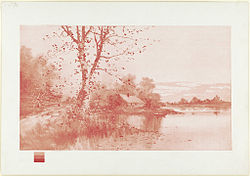CMYK
Color printing involves a series of steps, or transformations, to generate a quality color reproduction. The following sections focus on the steps used when reproducing a color image in CMYK printing.
Any natural scene or color photograph can be optically and physiologically dissected into three primary colors, red, green and blue, roughly equal amounts of which give rise to the perception of white, and different proportions of which give rise to the visual sensations of all other colors. The additive combination of any two primary colors in roughly equal proportion gives rise to the perception of a secondary color. For example, red and green yields yellow, red and blue yields magenta (a purple hue), and green and blue yield cyan (a turquoise hue). Only yellow is counter-intuitive. Yellow, cyan and magenta are merely the "basic" secondary colors: unequal mixtures of the primaries give rise to perception of many other colors all of which may be considered "tertiary". While there are many techniques for reproducing images in color, graphic processes and industrial equipment are used for the mass reproduction of color images on paper. In this sense, "color printing" involves reproduction techniques suited for printing presses capable of thousands or millions of impressions for publishing newspapers and magazines, brochures, cards, posters and similar mass-market items. In this type of industrial or commercial printing, the technique used to print full-color images, such as color photographs, is referred to as four-color-process or merely process printing. Four inks are used: three secondary colors plus black. These ink colors are cyan, magenta, yellow and key (black); abbreviated as CMYK. Because images are often prepared in RGB for screens, color management workflows convert them to press-ready CMYK while aiming to preserve the intended appearance.
Cyan can be thought of as minus-red, magenta as minus-green and yellow as minus-blue. These inks are semi-transparent (translucent). Where two inks overlap on the paper due to sequential printing impressions, a primary color is perceived. For example, yellow (minus-blue) overprinted by magenta (minus green) yields red. Where the three inks may overlap, almost all incident light is absorbed or subtracted, yielding near black, but in practical terms it is better and cheaper to use a separate black ink instead of combining three colored inks. The secondary or subtractive colors cyan, magenta and yellow may be considered "primary" by printers and watercolorists (whose basic inks and paints are transparent).
Two graphic techniques are required to prepare images for four-color printing. In the "pre-press" stage, original images are translated into forms that can be used on a printing press, through "color separation" and "screening" or "halftoning". These steps make possible the creation of printing plates that can transfer color impressions to paper on printing presses based on the principles of lithography.
A method of full-color printing is six-color process printing (for example, Pantone's Hexachrome system) which adds orange and green to the traditional CMYK inks for a larger and more vibrant gamut, or color range. However, such alternate color systems still rely on color separation, halftoning and lithography to produce printed images. Six color printing is widely used to increase the printability and so that to increase the production.
An emerging method is extended gamut printing or 7 color printing which adds three more colors such as green, orange and violet to extend the printability or gamut so that a wide range of Pantone colors also can be reproduced without changing the ink settings. This method is also called OGV printing. [6] The digital inkjet printers such as EPSON SureColor series has been using this method successfully to reproduce 99% Pantone colors.
Color printing can also involve as few as one color ink or color inks which are not the primary colors. Using a limited number of color inks, or color inks in addition to the primary colors, is referred to as "spot color" printing. Generally, spot-color inks are formulations that are designed to print alone, rather than to blend with other inks on the paper to produce various hues and shades. The range of spot color inks, much like paint, is nearly unlimited and much more varied than the colors that can be produced by four-color-process printing. Spot-color inks range from subtle pastels to intense fluorescents to reflective metallics.









